Street Trees as Sustainable Urban Air Purifiers: A Methodological Approach to Assessing Particulate Matter Phytofiltration
Abstract
1. Introduction
2. Materials and Methods
2.1. Tree Inventory
2.2. The i-Tree Eco Model
2.3. Assessment of Suspended Particulate Matter Accumulation Using Laboratory Methods
2.3.1. Plant Material and Data Harvesting
2.3.2. Quantitative Assessment of PM per cm2 of Leaf
2.3.3. Quantitative Assessment of PM per Tree and All the Trees in the Avenue
2.3.4. Statistical Analysis
3. Results
3.1. i-Tree Eco
3.2. Comparison of Methods
4. Discussion
4.1. Technical Aspects of the Methods Analysed
4.2. Differences in the Results Obtained with the Two Methods–Model and Empirical Method
4.3. Potential Reasons for Differences Between Methods
4.4. Benefits of Urban Tree Planting
5. Conclusions
Author Contributions
Funding
Institutional Review Board Statement
Informed Consent Statement
Data Availability Statement
Conflicts of Interest
References
- Guyatt, A.L.; Cai, Y.S.; Doiron, D.; Tobin, M.D.; Hansell, A.L. Air pollution, lung function and mortality: Survival and mediation analyses in UK Biobank. ERJ Open Res. 2024, 10, 00093-2024. [Google Scholar] [CrossRef]
- Syuhada, G.; Akbar, A.; Hardiawan, D.; Pun, V.; Darmawan, A.; Heryati, S.H.A.; Siregar, A.Y.M.; Kusuma, R.R.; Driejana, R.; Ingole, V.; et al. Impacts of air pollution on health and cost of illness in Jakarta, Indonesia. Int. J. Environ. Res. Public Health 2023, 20, 2916. [Google Scholar] [CrossRef] [PubMed]
- Brook, R.D.; Franklin, B.; Cascio, W.; Hong, Y.; Howard, G.; Lipsett, M.; Luepker, R.; Mittleman, M.; Samet, J.; Smith, S.C., Jr.; et al. Air pollution and cardiovascular disease: A statement for healthcare professionals from the expert panel on population and prevention science of the American Heart Association. Circulation 2004, 109, 2655–2671. [Google Scholar] [CrossRef] [PubMed]
- Brook, R.D.; Rajagopalan, S.; Pope, C.A., 3rd; Brook, J.R.; Bhatnagar, A.; Diez-Roux, A.V.; Holguin, F.; Hong, Y.; Luepker, R.V.; Mittleman, M.A.; et al. Particulate matter air pollution and cardiovascular disease: An update to the scientific statement from the American Heart Association. Circulation 2010, 121, 2331–2378. [Google Scholar] [CrossRef]
- Pope, C.A., III.; Dockery, D.W. Health effects of fine particulate air pollution: Lines that connect. J. Air Waste Manag. Assoc. 2006, 56, 709–742. [Google Scholar] [CrossRef]
- Dockery, D.; Pope, C.; Xu, X.; Spengler, J.; Ware, J.; Fay, M. An association between air-pollution and mortality in 6 United-States cities. N. Engl. J. Med. 1993, 329, 1753–1759. [Google Scholar] [CrossRef] [PubMed]
- Meng, X.; Ma, Y.; Chen, R.; Zhou, Z.; Chen, B.; Kan, H. Size-fractionated particle number concentrations and daily mortality in a Chinese city. Environ. Health Perspect. 2013, 121, 1174–1178. [Google Scholar] [CrossRef]
- Stanaway, J.D.; Afshin, A.; Gakidou, E.; Lim, S.S.; Abate, D.; Abate, K.H.; Abbafati, C.; Abbasi, N.; Abbastabar, H.; Abd-Allah, F.; et al. Global, regional, and national comparative risk assessment of 84 behavioural, environmental and occupational, and metabolic risks or clusters of risks for 195 countries and territories, 1990–2017: A systematic analysis for the Global Burden of Disease Study 2017. Lancet 2018, 392, 1923–1994. [Google Scholar] [CrossRef]
- Vos, T.; Slim, S.; Abbafati, C.; Abbas, K.M.; Abbasi, M.; Abbasifard, M.; Abbasi-Kangevari, M.; Abbastabar, H.; Abd-Allah, F.; Abdelalim, A.; et al. Global burden of 369 diseases and injuries in 204 countries and territories, 1990–2019: A systematic analysis for the Global Burden of Disease Study 2019. Lancet 2020, 396, 1204–1222. [Google Scholar] [CrossRef]
- Pandey, A.; Behera, S.K.; Dwivedi, S.; Singh, V.K.; Pandey, V. Assessment of phytodiversity and phytoremediation potential of plants in the vicinity of a thermal power plant. Int. J. Phytoremediat. 2024, 26, 1863–1872. [Google Scholar] [CrossRef]
- Mandal, M.; Popek, R.; Przybysz, A.; Roy, A.; Das, S.; Sarkar, A. Breathing fresh air in the city: Implementing avenue trees as a sustainable solution to reduce particulate pollution in urban agglomerations. Plants 2023, 12, 1545. [Google Scholar] [CrossRef]
- Petrova, S. The added value of urban trees (Tilia tomentosa Moench, Fraxinus excelsior L. and Pinus nigra J.F. Arnold) in terms of air pollutant removal. Forests 2024, 15, 1034. [Google Scholar] [CrossRef]
- Chen, D.; Yan, J.; Sun, N.; Sun, W.; Zhang, W.; Long, Y.; Yin, S. Selective capture of PM2.5 by urban trees: The role of leaf wax composition and physiological traits in air quality enhancement. J. Hazard. Mater. 2024, 478, 135428. [Google Scholar] [CrossRef]
- Saadat, O.; Teiri, H.; Mohammadi, F.; Hajizadeh, Y. Accumulation of heavy metals in the leaves of different tree species and its association with the levels of atmospheric PM2.5-bond heavy metals in Isfahan. Int. J. Phytoremediat. 2025, 27, 260–270. [Google Scholar] [CrossRef]
- Steinparzer, M.; Schaubmayr, J.; Godbold, D.L.; Rewald, B. Particulate matter accumulation by tree foliage is driven by leaf habit types, urbanization-and pollution levels. Environ. Pollut. 2023, 335, 122289. [Google Scholar] [CrossRef]
- Shan, Y.; Shen, Z.; Zhou, P.; Zou, X.; Che, S.; Wang, W. Quantifying air pollution attenuation within urban parks: An experimental approach in Shanghai, China. Environ. Pollut. 2011, 159, 2155–2163. [Google Scholar] [CrossRef] [PubMed]
- Dazzi, C.; Lo Papa, G. Anthropogenic soils: General aspects and features. Ecocycles 2015, 1, 3–8. [Google Scholar] [CrossRef]
- McDonald, A.G.; Bealey, W.J.; Fowler, D.; Dragosits, U.; Skiba, U.; Smith, R.I.; Donovan, R.G.; Brett, H.E.; Hewitt, C.N.; Nemitz, E. Quantifying the effect of urban tree planting on concentrations and depositions of PM10 in two UK conurbations. Atmos. Environ. 2007, 41, 8455–8467. [Google Scholar] [CrossRef]
- Sicard, P.; Pascu, I.-S.; Petrea, S.; Leca, S.; De Marco, A.; Paoletti, E.; Agathokleous, E.; Calatayud, V. Effect of tree canopy cover on air pollution-related mortality in European cities: An integrated approach. Lancet Planet. Health 2025, 9, e527–e537. [Google Scholar] [CrossRef]
- Li, Y.; Chen, X.; Sonne, C.; Lam, S.S.; Yang, Y.; Ma, N.L.; Peng, W. Reduction and control of air pollution: Based on plant-microbe interactions. Environ. Pollut. Bioavailab. 2023, 35, 2173657. [Google Scholar] [CrossRef]
- Barnes, M.J.; Brade, T.K.; MacKenzie, A.R.; Whyatt, J.D.; Carruthers, D.J.; Stocker, J.; Cai, X.; Hewitt, C.N. Spatially-varying surface roughness and ground-level air quality in an operational dispersion model. Environ. Pollut. 2014, 185, 44–51. [Google Scholar] [CrossRef]
- Mazur, J. Plants as natural anti-dust filters—Preliminary research. Tech. Trans. 2018, 115, 165–172. [Google Scholar] [CrossRef]
- Nowak, D.J.; Crane, D.E.; Stevens, J.C. Air pollution removal by urban trees and shrubs in the United States. Urban For. Urban Green. 2006, 4, 115–123. [Google Scholar] [CrossRef]
- Pace, R.; Guidolotti, G.; Baldacchini, C.; Pallozzi, E.; Grote, R.; Nowak, D.J.; Calfapietra, C. Comparing i-Tree Eco estimates of particulate matter deposition with leaf and canopy measurements in an urban Mediterranean holm oak forest. Environ. Sci. Technol. 2021, 55, 6613–6622. [Google Scholar] [CrossRef]
- Vashist, M.; Kumar, T.V.; Singh, S.K. Assessment of air quality benefits of vegetation in an urban-industrial region of India by integrating air monitoring with i-Tree Eco model. Clean-Soil Air Water 2024, 52, 2300198. [Google Scholar] [CrossRef]
- Satoshi, H.; Kroll, C.N.; Nowak, D.J.; Endreny, T.A. I-Tree eco dry deposition model descriptions. Citeseer 2012, 36, 1–43. [Google Scholar]
- Nersisyan, G.; Przybysz, A.; Vardanyan, Z.; Sayadyan, H.; Muradyan, N.; Grigoryan, M.; Ktrakyan, S. Peculiarities of particulate matter absorption by urban tree species in the major cities of Armenia. Sustainability 2024, 16, 10217. [Google Scholar] [CrossRef]
- Popek, R.; Roy, A.; Mandal, M.; Przybysz, A.; Drążkiewicz, K.; Romanowska, P.; Sarkar, A. Enhancing urban sustainability: How spatial and height variability of roadside plants improves pollution capture for greener cities. Sustainability 2024, 16, 11131. [Google Scholar] [CrossRef]
- Roy, A.; Das, S.; Singh, P.; Mandal, M.; Kumar, M.; Rajlaxmi, A.; Vijayan, N.; Awasthi, A.; Chhetri, H.; Roy, S.; et al. Summer-time monitoring and source apportionment study of both coarse, fine, and ultra-fine particulate pollution in Eastern Himalayan Darjeeling: A hint to health risk during peak tourist season. MAPAN 2024, 39, 995–1009. [Google Scholar] [CrossRef]
- Sgrigna, G.; Baldacchini, C.; Dreveck, S.; Cheng, Z.; Calfapietra, C. Relationships between air particulate matter capture efficiency and leaf traits in twelve tree species from an Italian urban-industrial environment. Sci. Total Environ. 2020, 718, 137310. [Google Scholar] [CrossRef]
- Wang, L.; Gong, H.; Liao, W.; Wang, Z. Accumulation of particles on the surface of leaves during leaf expansion. Sci. Total Environ. 2015, 532, 420–434. [Google Scholar] [CrossRef]
- Muhammad, S.; Wuyts, K.; Samson, R. Atmospheric net particle accumulation on 96 plant species with contrasting morphological and anatomical leaf characteristics in a common garden experiment. Atmos. Environ. 2019, 202, 328–344. [Google Scholar] [CrossRef]
- Shao, F.; Wang, L.; Sun, F.; Li, G.; Yu, L.; Wang, Y.; Zeng, X.; Yan, H.; Dong, L.; Bao, Z. Study on different particulate matter retention capacities of the leaf surfaces of eight common garden plants in Hangzhou, China. Sci. Total Environ. 2019, 652, 939–951. [Google Scholar] [CrossRef]
- Zhang, Y.; Tang, L.; Croteau, P.L.; Favez, O.; Sun, Y.; Canagaratna, M.R.; Wang, Z.; Couvidat, F.; Albinet, A.; Zhang, H.; et al. Field characterization of the PM2.5 aerosol chemical speciation monitor: Insights into the composition, sources, and processes of fine particles in eastern China. Atmos. Chem. Phys. 2017, 17, 14501–14517. [Google Scholar] [CrossRef]
- Poland in Numbers. The City of Warsaw in Numbers. Available online: https://www.polskawliczbach.pl/Warszawa (accessed on 3 August 2025).
- Euractiv.pl. Available online: https://www.euractiv.pl/section/energia-i-srodowisko/news/mroz-smog-piec-warszawa-wroclaw-zanieczyszczenie-powietrze-miasta/ (accessed on 3 August 2025).
- NOIZZ Ekologia. Available online: https://noizz.pl/ekologia/warszawa-gorsza-niz-kalkuta-jest-na-2-miejscu-miast-z-najgorszym-powietrzem/c3jn196 (accessed on 3 August 2025).
- Climate Change, Impacts and Vulnerability in Europe 2012; EEA Report No 12/2012; An Indicator-Based Report; EEA: Copenhagen, Denmark, 2012; pp. 168–204.
- i-Tree Eco User’s Manual. Available online: https://www.itreetools.org/documents/275/EcoV6_UsersManual.2021.09.22.pdf (accessed on 3 August 2025).
- Przybysz, A.; Nersisyan, G.; Gawroński, S.W. Removal of particulate matter and trace elements from ambient air by urban greenery in the winter season. Environ. Sci. Pollut. Res. 2019, 26, 473–482. [Google Scholar] [CrossRef] [PubMed]
- Selmi, W.; Weber, C.; Rivière, E.; Blond, N.; Mehdi, L.; Nowak, D. Air pollution removal by trees in public green spaces in Strasbourg city, France. Urban For. Urban Green. 2016, 17, 192–201. [Google Scholar] [CrossRef]
- Gong, C.; Xian, C.; Ouyang, Z. Assessment of no2 purification by urban forests based on the i-tree eco model: Case study in beijing, china. Forests 2022, 13, 369. [Google Scholar] [CrossRef]
- Grandesso, E.; Ballesta, P.P.; Kowalewski, K. Thermal desorption GC–MS as a tool to provide PAH certified standard reference material on particulate matter quartz filters. Talanta 2013, 105, 101–108. [Google Scholar] [CrossRef] [PubMed]
- Gaglio, M.; Pace, R.; Muresan, A.N.; Grote, R.; Castaldelli, G.; Calfapietra, C.; Fano, E.A. Species-Specific Efficiency in PM2.5 Removal by Urban Trees: From Leaf Measurements to Improved Modeling Estimates. Sci. Total Environ. 2022, 844, 157131. [Google Scholar] [CrossRef] [PubMed]
- Galvão, A.; Segers, I.; Smitz, J.; Tournaye, H.; De Vos, M. In vitro maturation (IVM) of oocytes in patients with resistant ovary syndrome and in patients with repeated deficient oocyte maturation. J. Assist. Reprod. Genet. 2018, 35, 2161–2171. [Google Scholar] [CrossRef]
- Sarzanin, C. Recent developments in ion chromatography. J. Chromatogr. A 2002, 956, 3–13. [Google Scholar] [CrossRef]
- López-Ruiz, B. Advances in the determination of inorganic anions by ion chromatography. J. Chromatogr. A 2000, 881, 607–627. [Google Scholar] [CrossRef] [PubMed]
- Chaudhary, I.J.; Rathore, D. Dust Pollution: Its Removal and Effect on Foliage Physiology of Urban Trees. Sustain. Cities Soc. 2019, 51, 101696. [Google Scholar] [CrossRef]
- Nowak, D.; Crane, D.; Stevens, J.; Hoehn, R.; Walton, J.; Bond, J. A Ground-Based Method of Assessing Urban Forest Structure and Ecosystem Services. Arboric. Urban For. 2008, 34, 347–358. [Google Scholar] [CrossRef]
- Bagstad, K.J.; Semmens, D.J.; Waage, S.; Winthrop, R. A Comparative Assessment of Decision-Support Tools for Ecosystem Services Quantification and Valuation. Ecosyst. Serv. 2013, 5, 27–39. [Google Scholar] [CrossRef]
- Kim, G. Assessing Urban Forest Structure, Ecosystem Services, and Economic Benefits on Vacant Land. Sustainability 2016, 8, 679. [Google Scholar] [CrossRef]
- Przybysz, A.; Sæbø, A.; Hanslin, H.M.; Gawroński, S.W. Accumulation of Particulate Matter and Trace Elements on Vegetation as Affected by Pollution Level, Rainfall and the Passage of Time. Sci. Total Environ. 2014, 481, 360–369. [Google Scholar] [CrossRef]
- Pike, K.; O’Herrin, K.; Klimas, C.; Vogt, J. Tree Preservation during Construction: An Evaluation of a Comprehensive Municipal Tree Ordinance. Urban For. Urban Green. 2021, 57, 126914. [Google Scholar] [CrossRef]
- Suchocka, M.; Jankowski, P.; Błaszczyk, M. Tree Protection on Construction Sites—Knowledge and Perception of Polish Professionals. Urban For. Urban Green. 2019, 46, 126436. [Google Scholar] [CrossRef]
- Watson, G.W.; Kelsey, P. The Impact of Soil Compaction on Soil Aeration and Fine Root Density of Quercus palustris. Urban For. Urban Green. 2006, 4, 69–74. [Google Scholar] [CrossRef]
- Hilbert, D.R.; Roman, L.A.; Koeser, A.K.; Vogt, J.; van Doorn, N.S. Urban Tree Mortality: A Literature Review. Arboric. Urban For. 2019, 45, 167–200. [Google Scholar] [CrossRef]
- Olchowik, J.; Suchocka, M.; Jankowski, P.; Malewski, T.; Hilszczańska, D. The ectomycorrhizal community of urban linden trees in Gdańsk, Poland. PLoS ONE 2021, 16, e0237551. [Google Scholar] [CrossRef]
- Krzyżaniak, M.; Świerk, D.; Antoszewski, P. Factors Influencing the Health Status of Trees in Parks and Forests of Urbanized Areas. Forests 2021, 12, 656. [Google Scholar] [CrossRef]
- Martinez, C.; Coelho-Duarte, A. Hazard indicators in urban trees. case studies on platanus x hispanica mill. ex münchh and morus alba l. in mendoza city-argentina. Rev. De La Fac. De Cienc. Agrar. Uncuyo 2023, 55, 152–165. [Google Scholar] [CrossRef]
- Berrang, P.; Karnosky, D.F.; Stanton, B.J. The role of water stress in tree growth. Arboric. Urban For. 1985, 11, 185–189. [Google Scholar] [CrossRef]
- Kociel, H.; Kalaji, H.; Suchocka, M.; Tuchowska, Ż. Structural soil as one of the pro ecological solutions for cities. Ecol. Eng. Environ. Technol. 2018, 19, 81–90. [Google Scholar] [CrossRef] [PubMed]
- Suchocka, M.; Swoczyna, T.; Kosno-Jończy, J.; Kalaji, H.M. Impact of heavy pruning on development and photosynthesis of Tilia cordata Mill. trees. PLoS ONE 2021, 16, e0256465. [Google Scholar] [CrossRef]
- Górka, M.; Bartz, W.; Skuridina, A.; Potysz, A. Populus nigra Italica Leaves as a Valuable Tool for Mineralogical and Geochemical Interpretation of Inorganic Atmospheric Aerosols’ Genesis. Atmosphere 2020, 11, 1126. [Google Scholar] [CrossRef]
- Popek, R.; Przybysz, A.; Gawrońska, H.; Klamkowski, K.; Gawroński, S.W. Impact of Particulate Matter Accumulation on the Photosynthetic Apparatus of Roadside Woody Plants Growing in the Urban Conditions. Ecotoxicol. Environ. Saf. 2018, 163, 56–62. [Google Scholar] [CrossRef] [PubMed]
- Staples, T.; Dwyer, J.M.; Mayfield, M.M.; England, J.R. Productivity does not correlate with species and functional diversity in Australian reforestation plantings across a wide climate gradient. Glob. Ecol. Biogeogr. 2019, 28, 1003–1015. [Google Scholar] [CrossRef]
- Quigley, M.F. Street trees and rural conspecifics: Will long-lived trees reach full size in urban conditions? Urban Ecosyst. 2004, 7, 29–39. [Google Scholar] [CrossRef]
- Błońska, E.; Lasota, J.; Prażuch, W.; Ilek, A. Vertical variations in enzymatic activity and C:N:P stoichiometry in forest soils under the influence of different tree species. Eur. J. For. Res. 2025, 144, 83–94. [Google Scholar] [CrossRef]
- Zhang, B.; Wang, W.; He, X.; Zhou, W.; Xiao, L.; Lv, H.; Wei, C. Urban forest characteristics and ecological services in Harbin. Chin. J. Ecol. 2017, 36, 951–961. [Google Scholar]
- Riondato, E.; Pilla, F.; Sarkar Basu, A.S.; Sarkar Basu, B. Investigating the effect of trees on urban quality in Dublin by combining air monitoring with i-Tree Eco model. Sustain. Cities Soc. 2020, 61, 102356. [Google Scholar] [CrossRef]
- Fuller, R.A.; Irvine, K.N.; Devine-Wright, P.; Warren, P.H.; Gaston, K.J. Psychological benefits of greenspace increase with biodiversity. Biol. Lett. 2007, 3, 390–394. [Google Scholar] [CrossRef]
- van den Berg, M.; van Poppel, M.; van Kamp, I.; Andrusaityte, S.; Balseviciene, B.; Cirach, M.; Danileviciute, A.; Ellis, N.; Hurst, G.; Masterson, D.; et al. Visiting green space is associated with mental health and vitality: A cross-sectional study in four european cities. Health Place 2016, 38, 8–15. [Google Scholar] [CrossRef] [PubMed]
- Hanski, I.; von Hertzen, L.; Fyhrquist, N.; Koskinen, K.; Torppa, K.; Laatikainen, T.; Karisola, P.; Auvinen, P.; Paulin, L.; Mäkelä, M.J.; et al. Environmental biodiversity, human microbiota, and allergy are interrelated. Proc. Natl. Acad. Sci. USA 2012, 109, 8334–8339. [Google Scholar] [CrossRef] [PubMed]
- Hopkins, L.; January-Bevers, D.; Caton, E.I.; Campos, L. Prosty model sadzenia drzew w celu poprawy klimatu, zanieczyszczenia powietrza, zdrowia i upałów miejskich w lokalizacjach narażonych na zmiany klimatu z wykorzystaniem partnerów nietradycyjnych. Plants People Planet 2021, 4, 243–257. [Google Scholar] [CrossRef]

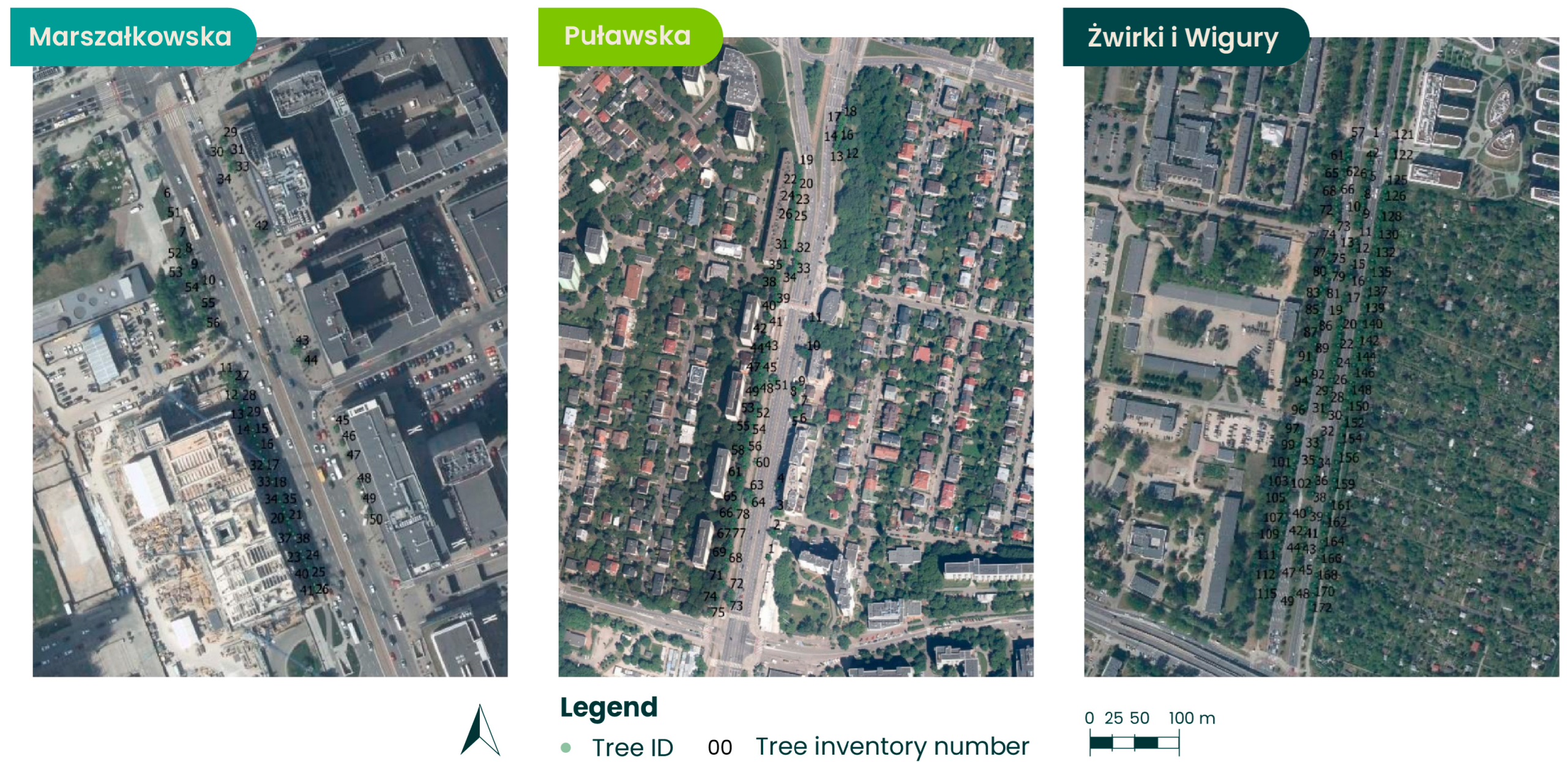


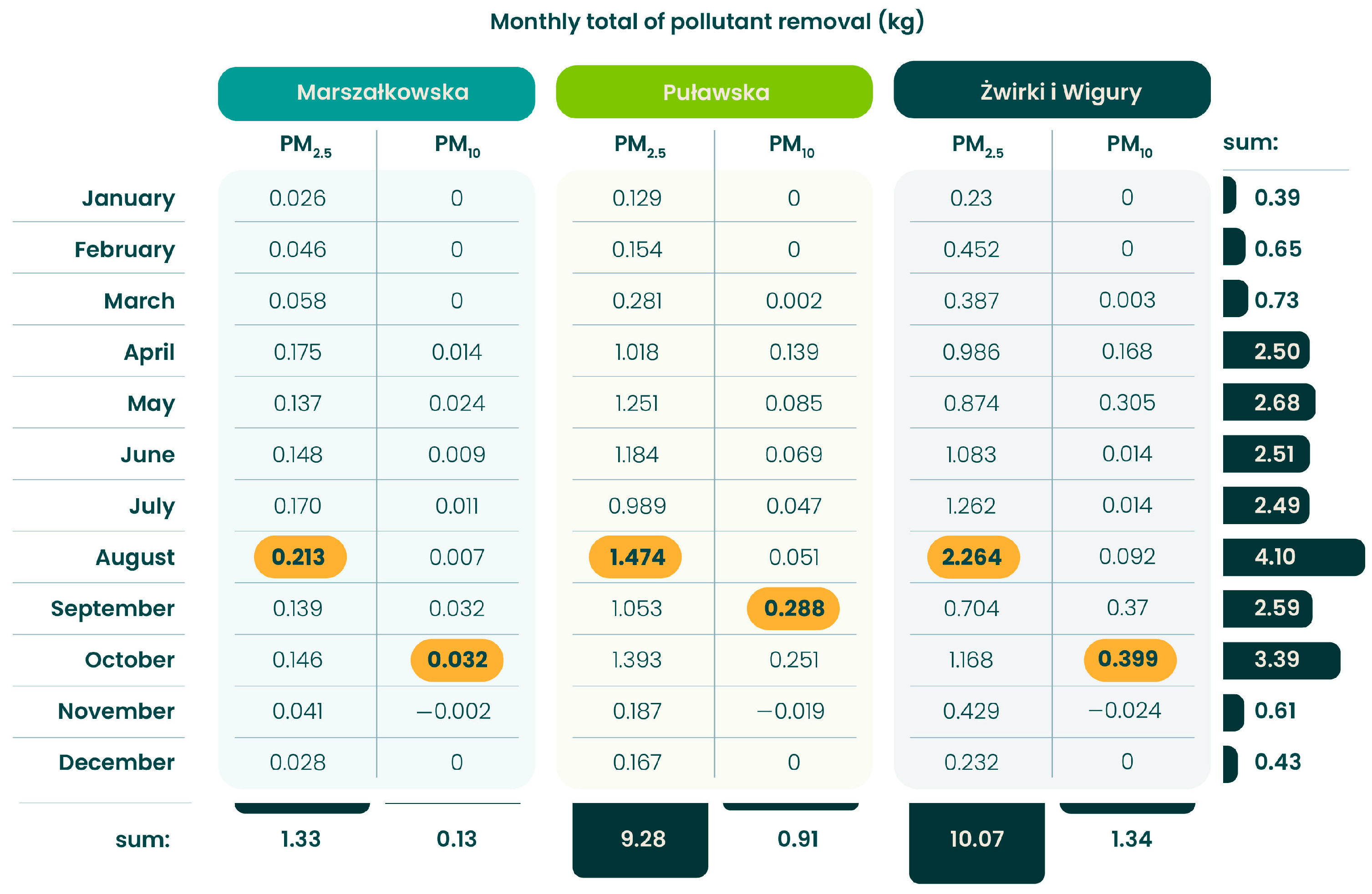
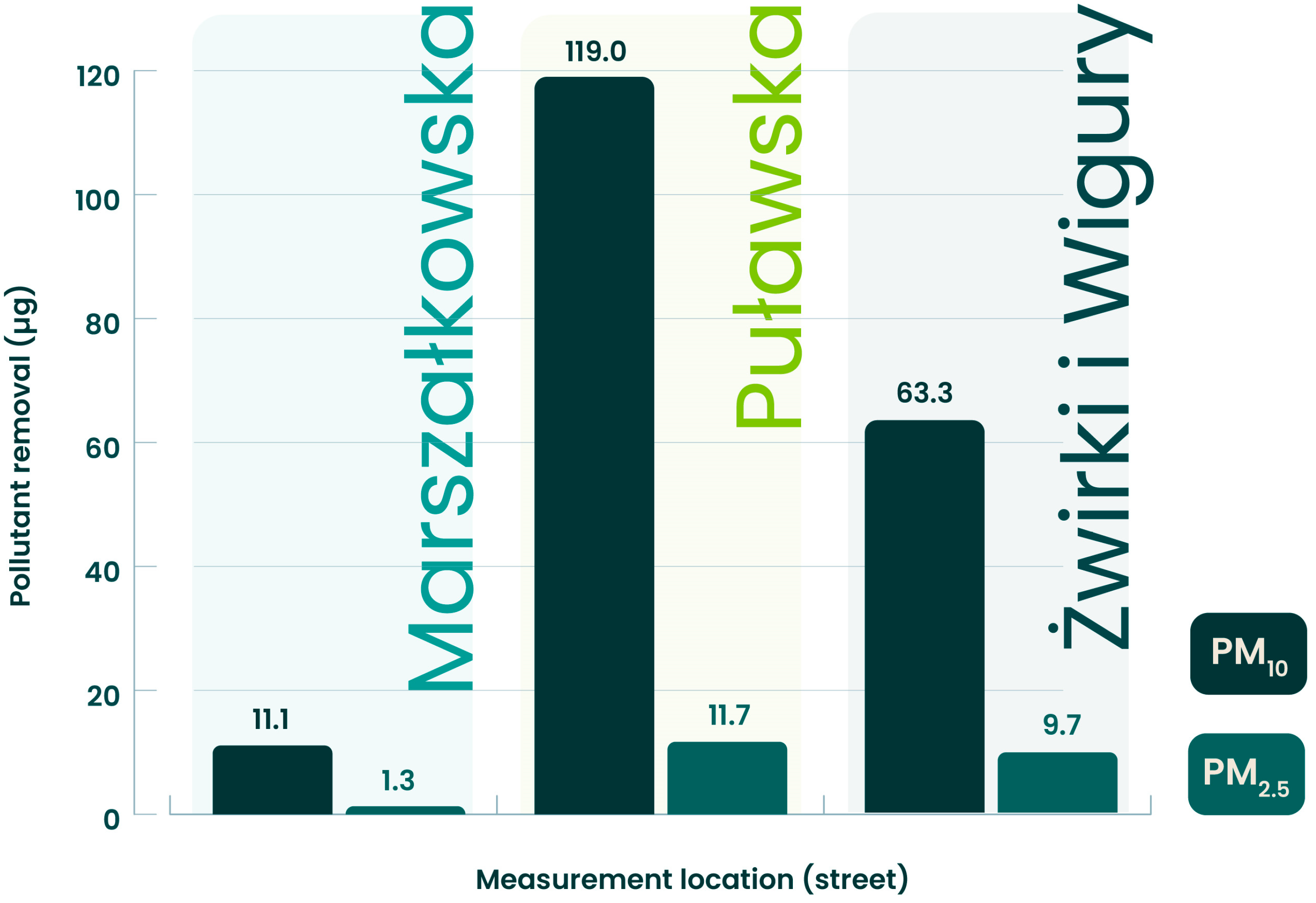
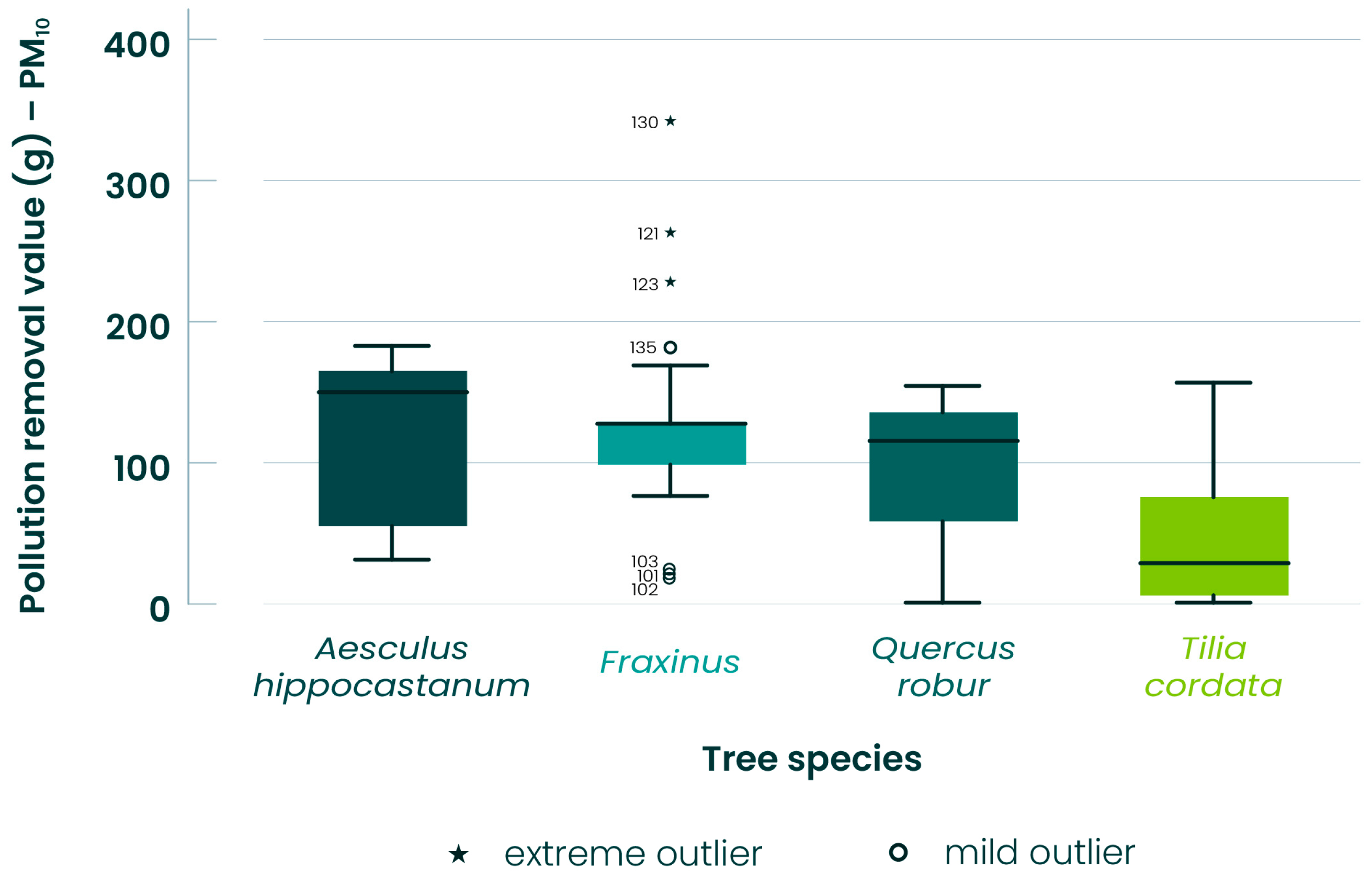
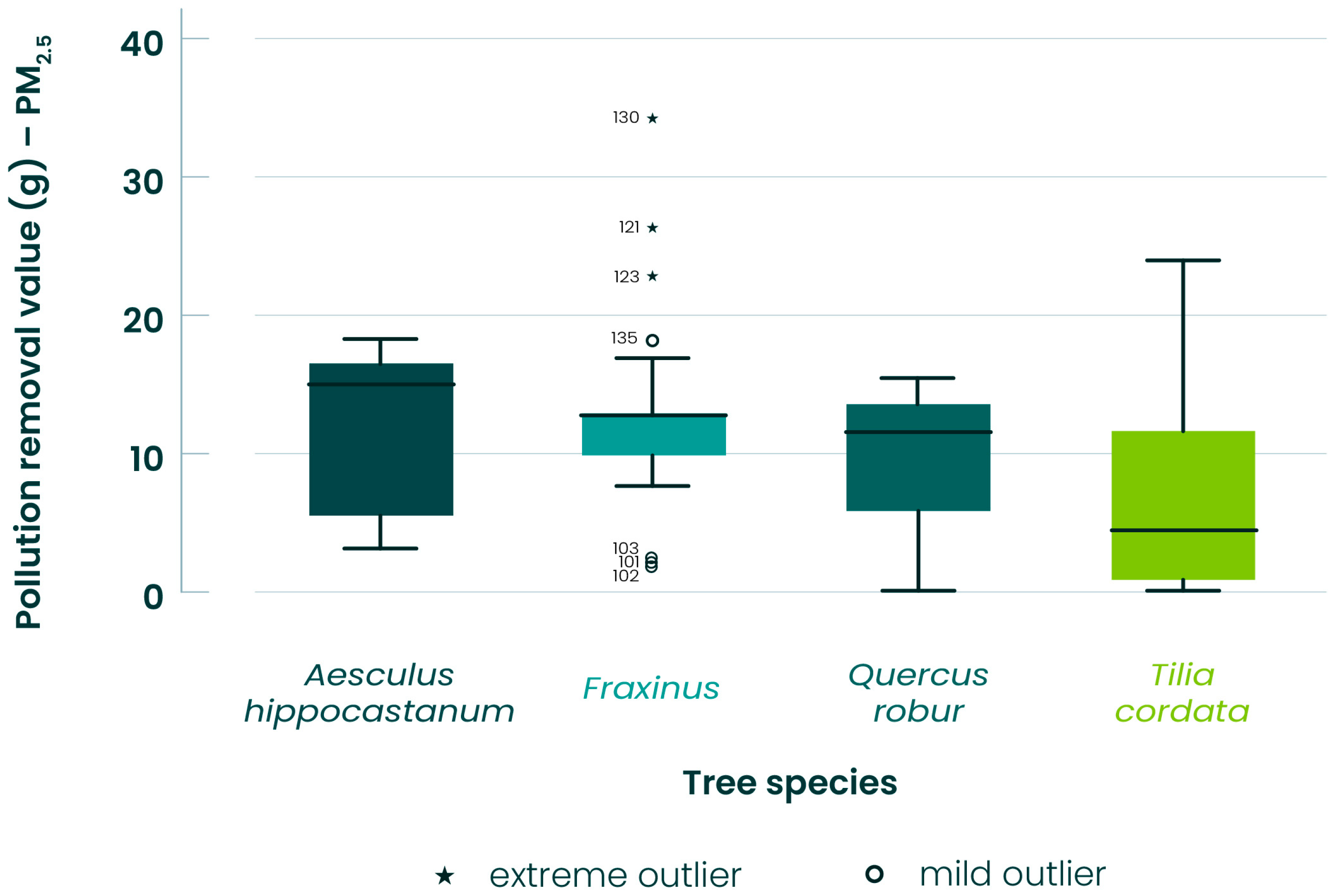
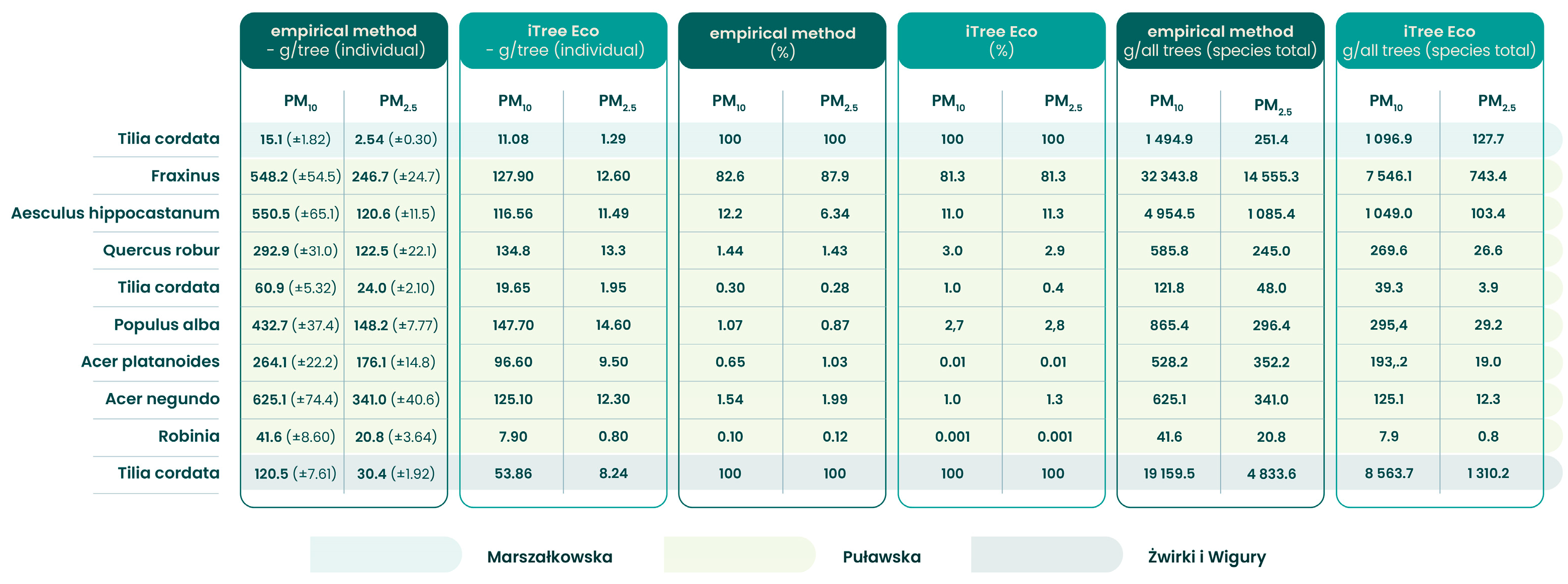
| Element/Step | i-Tree Eco | Empirical Laboratory Method |
|---|---|---|
| Data source | Tree inventory (dendrometric measurements), meteorological data, air quality (Warsaw) | Leaf samples (500 cm2), collected from 4 trees/species across 3 urban locations |
| Analytical approach | Ecosystem modelling based on USDA data and i-Tree database | Laboratory: PM quantification by fractionation and gravimetric analysis |
| PM type analyzed | PM2.5 and PM10 (simulated values across the vegetative season) | PM2.5 and PM10 (actual deposited mass on leaves) |
| Time reference | Modelled for full vegetative season | Actual state during sampling (following high PM episode in July 2023), calculated per full vegetative season based on i-Tree Eco and precipitation data |
| Rainfall consideration | Yes—simulated wash-off based on precipitation data | Yes—seasonal extrapolation using literature-based wash-off coefficients (Przybysz et al. [52]) |
| Seasonal variability | Included (e.g., leaf presence, precipitation, temperature) | Not included—single sampling timepoint |
| Output | Simulated PM absorption per tree/alley/season | Measured PM mass per tree, extrapolated to vegetative season |
| Strengths | Rapid assessment, applicable to large-scale urban areas | High local accuracy, based on real environmental exposure |
| Limitations | Calibrated for US data; potential mismatch with local conditions | Labor-intensive; sensitive to sampling timing and individual tree selection |
Disclaimer/Publisher’s Note: The statements, opinions and data contained in all publications are solely those of the individual author(s) and contributor(s) and not of MDPI and/or the editor(s). MDPI and/or the editor(s) disclaim responsibility for any injury to people or property resulting from any ideas, methods, instructions or products referred to in the content. |
© 2025 by the authors. Licensee MDPI, Basel, Switzerland. This article is an open access article distributed under the terms and conditions of the Creative Commons Attribution (CC BY) license (https://creativecommons.org/licenses/by/4.0/).
Share and Cite
Kais, K.; Suchocka, M.; Balcerzak, O.; Przybysz, A. Street Trees as Sustainable Urban Air Purifiers: A Methodological Approach to Assessing Particulate Matter Phytofiltration. Sustainability 2025, 17, 7451. https://doi.org/10.3390/su17167451
Kais K, Suchocka M, Balcerzak O, Przybysz A. Street Trees as Sustainable Urban Air Purifiers: A Methodological Approach to Assessing Particulate Matter Phytofiltration. Sustainability. 2025; 17(16):7451. https://doi.org/10.3390/su17167451
Chicago/Turabian StyleKais, Karolina, Marzena Suchocka, Olga Balcerzak, and Arkadiusz Przybysz. 2025. "Street Trees as Sustainable Urban Air Purifiers: A Methodological Approach to Assessing Particulate Matter Phytofiltration" Sustainability 17, no. 16: 7451. https://doi.org/10.3390/su17167451
APA StyleKais, K., Suchocka, M., Balcerzak, O., & Przybysz, A. (2025). Street Trees as Sustainable Urban Air Purifiers: A Methodological Approach to Assessing Particulate Matter Phytofiltration. Sustainability, 17(16), 7451. https://doi.org/10.3390/su17167451







